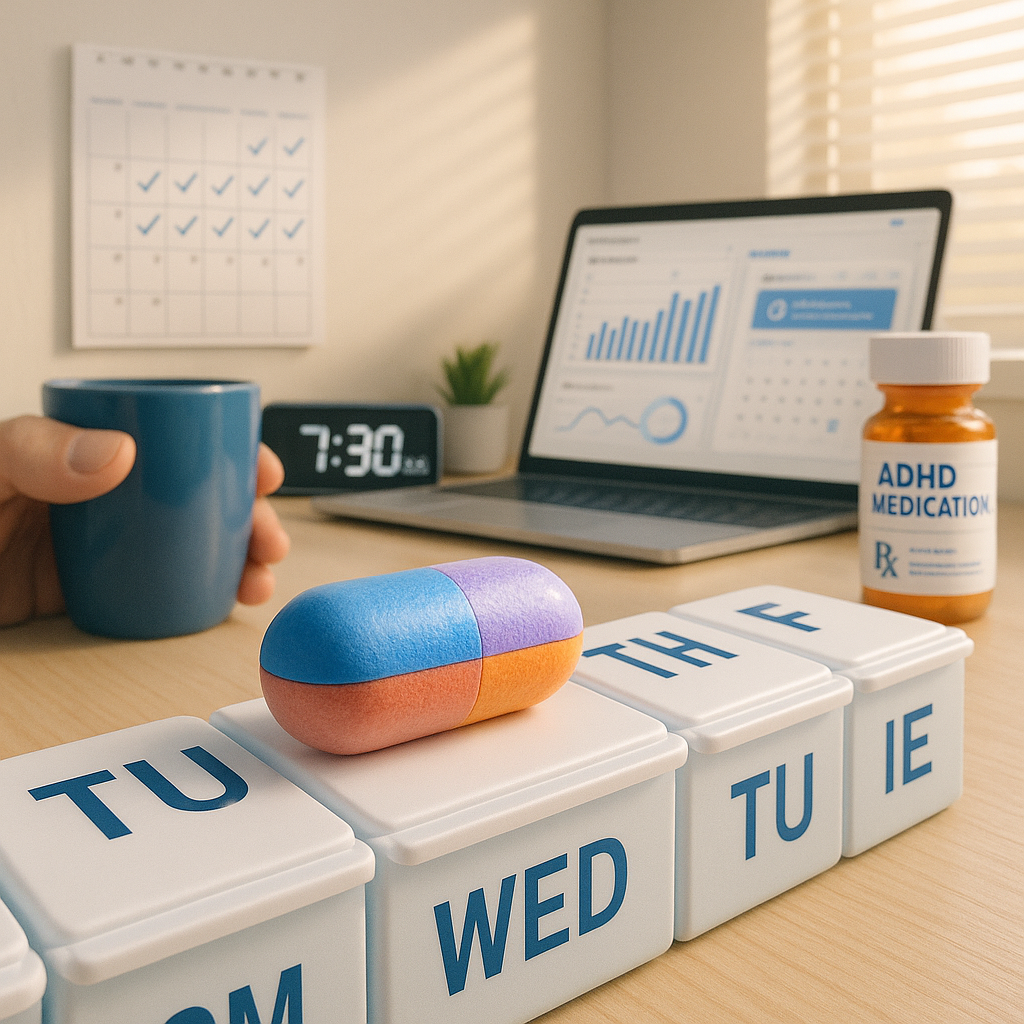Key Takeaways
- Anchor your ritual with comfort and cues: Boost consistency by pairing planning sessions with sensory comforts, such as your favorite drinks, music, cozy spaces, or relaxing scents. Add visible cues in your environment that signal focus and reward, priming your brain to enter planning mode.
- Adapt your environment to spark motivation: Designate a regular time and dedicated spot for planning, even if the specifics change week to week. A familiar corner, unique lighting, or special object can transform the task into a safe and inviting ritual.
- Build structure without boxing yourself in: Combine structured frameworks (like time-blocking or checklists) with built-in flexibility. Allow yourself to make playful shifts as life changes, and banish guilt when plans require midweek adjustments. Just tweak and pivot when needed.
- Make your review a celebration, not a chore: Turn weekly reviews into moments of reward by tracking small wins, reflecting on growth, and adding playful incentives. Celebrate the act of showing up for yourself, not just the items you check off.
- Use visual tools that clarify, not clutter: Integrate color-coding, stickers, or mind maps to support ADHD-friendly pattern recognition. Keep things visually simple, since too many elements can quickly spiral into overwhelm.
- Prioritize by real-life energy, not just urgency: Organize tasks by your natural energy rhythms, scheduling work when you feel most alert or creative. Tap into your own cycles rather than relying solely on arbitrary priority lists.
- Ritual anchoring: make consistency the real win. The hidden strength is not the system itself, but your enjoyment of the ritual. Positive associations (comfort, reward, ease) make consistency attainable, helping you return to your planning routine even when motivation dips.
Creating a consistent, rewarding planning ritual is about working with your brain’s wiring, not fighting it. Ahead, you’ll discover hands-on steps, real-world tips, and ADHD-friendly templates to build a weekly ritual that grounds you, reduces chaos, and makes life feel not just less scattered, but uniquely yours.
Introduction
The real challenge of weekly planning with ADHD is less about starting and more about persisting when motivation wanes or each week seems uniquely unpredictable. Traditional planners and rigid routines rarely stand the test of time for neurodivergent minds. They quickly disappear under stacks of paper or layers of guilt, leaving you feeling defeated. But what if the real breakthrough comes from making the planning ritual itself inviting and enjoyable? Imagine something on par with your favorite coffee, a cozy playlist, or a comforting corner.
Designing a weekly planning ritual tailored for ADHD is about creating an experience your mind actually wants, not avoids. When you root consistency in sensory cues, simple and satisfying visuals, and genuine celebration of wins (big or small), your “should-do” transforms into a supportive habit that sticks. This guide will show you how to make weekly planning ADHD-friendly, so your system flexes with your real life, flows with your energy, and builds true self-support, one week at a time.
Why Traditional Planning Systems Fail ADHD Brains
Most planning systems overlook the realities of neurodivergent thinking. These templates often assume steady executive function, reliable attention, and uniform energy. Expectations like these are far from the lived experience of many with ADHD. When you struggle to fit into these molds, it’s not a failure of willpower or motivation. Instead, it reveals a mismatch between the system and your unique operating system.
Key shortcomings of traditional planning approaches for ADHD:
- They demand sustained attention on tasks that don’t provide immediate satisfaction or dopamine.
- They presume linear, step-by-step thinking, while ADHD brains are more often associative, connecting ideas in dynamic patterns.
- They prize consistency over adaptability, punishing natural energy fluctuations instead of supporting them.
- They separate planning from action, making planning feel disconnected and unrewarding.
The result is a repeating cycle: initial excitement, mounting frustration, then discouragement. Each failed attempt can reinforce the belief that planning just “doesn’t work for me.” However, the real issue is not with you. It’s that you haven’t yet found an approach designed with your brain in mind.
The secret is not to muster more discipline but to craft a planning experience your brain truly anticipates. By leaning into ritual, sensory input, and positive rewards, planning can shift from a dreaded task to an eagerly awaited ritual.
The Power of Ritual Anchoring for ADHD Brains
Ritual anchoring does more than stack habits; it transforms routine into experience. For the dopamine-driven ADHD mind, weaving sensory and environmental anchors into your planning ritual makes the process as satisfying as it is productive.
Creating Your Planning Sanctuary
Your physical environment has an outsized influence on your willingness to engage with “boring” or demanding tasks. By transforming your planning area into a mini-sanctuary, you send a clear signal to your brain: this activity deserves special focus and care.
Strategies for curating your planning sanctuary:
- Choose a consistent location. This could be a specific corner, a favorite chair, or even a spot at a local café. It doesn’t need to be fancy, just dedicated.
- Add sensory signals exclusive to planning time, such as a particular candle, ambient lamp, special tea, or textured blanket.
- Create visual boundaries by using a dedicated placemat, room divider, or lighting that marks your “planning zone.”
Martin, a graphic designer with ADHD, transformed his planning ritual by setting up a salt lamp, donning noise-canceling headphones, and brewing a unique tea reserved just for planning. “Once that lamp glows and I smell my tea,” he says, “my brain knows it’s time to shift gears. It’s a comfort cue. I actually look forward to it.”
Temporal Anchoring: Timing Matters Too
When you schedule your ritual can make or break its sustainability. ADHD brains are sensitive to natural energy highs and lows, and planning at your optimal time builds momentum.
Consider these approaches:
- Track your peak energy and focus times over a week or two.
- If you take medication, align your planning window with its peak effectiveness.
- Link planning to another daily transition. Maybe after breakfast, as a lunch break ritual, or when winding down in the evening.
By aligning your planning with your existing rhythms, not arbitrary rules, you make it easier to show up. This might mean Sunday evenings for reflection or Monday mornings for a fresh start. The goal is to discover when your mind is most receptive, using experimentation and self-awareness as your guide. Consistency becomes a result of respect for your neurobiology, not rigid scheduling.
Sensory Elements That Make Planning Rewarding
For ADHD minds, sensory engagement is fundamental for holding attention. By blending tactile, auditory, and olfactory cues into your ritual, you introduce novelty and pleasure that can turn planning into a source of dopamine rather than drudgery.
The Tactile Experience: Tools That Feel Good to Use
Choosing tools that feel satisfying can help ground you in the moment. Consider:
- Experimenting with various paper textures and weights until you find one that feels engaging. Some prefer the grainy feedback of heavyweight paper, others like ultra-smooth surfaces.
- Trying different writing implements (pens, markers, pencils) to discover the grip, friction, and ink flow that feels best.
- For digital planners, investing in a stylus or app with haptic feedback or pleasant sound effects can enhance the experience.
Alicia, a middle school teacher, found a breakthrough using fountain pens. “The tactile pleasure and ink flow make it fun. It turns planning from something I dread into a treat.”
Auditory Anchors: The Soundtrack to Your Planning
Sound can help anchor your focus and mood. Strategies include:
- Curating a playlist reserved solely for planning: instrumental music, gentle beats, or even beloved movie scores.
- Adding background soundscapes like gentle café ambience, running water, rain, or white noise.
- Timing your sessions with apps or timers that use gentle, rewarding chimes or auditory cues.
Olfactory Triggers: The Invisible Enhancer
Scent directly impacts mood and memory, making it a potent tool for ritual-building.
- Choose a signature planning scent (candle, oil, or incense) only used during these sessions.
- Try using different scents for different aspects: invigorating citrus for brainstorming, calming lavender for goal review.
- Ensure your planning scent stays distinct from the rest of your environment so your brain makes a strong association.
Together, these sensory anchors create an immersive, multi-layered experience, helping your brain crave the ritual (and, by extension, the habits you’re building).
Designing Your Weekly Review Process
A compelling weekly review is the linchpin of sustainable ADHD-friendly planning. Weekly cycles balance structure and flexibility, avoiding the monotony of daily check-ins and the abstraction of monthly goals. However, the review process must be adapted specifically for ADHD tendencies to succeed.
The 4R Framework: Flexible Structure for Lasting Impact
A simple, repeatable framework can give structure without rigidity. Try the 4R approach:
- Reflect: Compassionately look back at the past week.
- What went as planned and what didn’t?
- Where did you find surprise pockets of focus or creativity?
- What barriers or new learnings came up?
- Reset: Clear physical and digital space for renewed focus.
- Tidy your planning spot or wipe down a whiteboard.
- Organize your digital workspace or clear out emails and notifications.
- Let go of any guilt or frustration from missed tasks.
- Reorient: Reconnect with your big-picture goals.
- Revisit your monthly or quarterly intentions.
- Highlight one to three key projects or focus areas for your week.
- Draw direct links from your weekly actions to your larger aspirations.
- Roadmap: Sketch out your adaptable weekly plan.
- Block out time for priority tasks or appointments.
- Anticipate possible obstacles and brainstorm potential pivots.
- Add buffer zones for the unexpected, allowing for the real-world ebb and flow of energy.
The real power of this framework lies in its blend of predictability and adaptability. The consistent steps reduce mental load while the content adjusts to your week’s circumstances.
Templates That Reduce Friction
For ADHD brains, the “blank page” can be paralyzing. Templates lower activation energy and offer a gentle nudge toward action:
- Use pre-made physical templates or customize your own with reusable notecards or transparent overlays.
- Set up digital planning tools with repeatable weekly shortcuts, or use automation to jumpstart your process.
- Try visuals like mind maps or color-coded grids that play to your brain’s strengths in pattern recognition.
Jordan, a marketing consultant, swears by a simple laminated weekly template. “I use wet-erase markers, and wiping it clean during my Reset phase feels like a fresh start. It’s faster and frees up my mental bandwidth.”
Beyond business and creative professions, ADHD-friendly weekly planning can also benefit educators managing dynamic classroom needs, healthcare workers balancing shifting shifts, and even parents coordinating varied family schedules. By adapting templates and rituals to your field, you can create reliable planning anchors that work across diverse environments.
Conclusion
Traditional planning systems have long failed to serve ADHD minds, not from a lack of effort or desire but because they often misalign with the realities of neurodivergence. By reframing planning as an engaging, multisensory ritual tailored to your environment, energy, and senses, you can transform a stereotypical “chore” into a rewarding act of self-support. Tactile, auditory, and olfactory cues offer dopamine in the form of comfort and novelty, making productivity less an act of struggle and more a byproduct of enjoyment.
The adaptable 4R framework and frictionless templates prove that effective planning doesn’t require rigidity. It thrives on a system designed around your strengths and rhythms. When you honor your unique wiring, planning becomes an act of empowerment. As the world grows ever more complex and demanding, individuals and teams who embrace neurodiversity in their workflows (whether in entrepreneurship, healthcare, education, or other fields) will unlock new levels of creativity and resilience.
Looking forward, the opportunity lies not in chasing conventional “productivity” but in building systems that make your rituals as rewarding as your results. Let your planning process become a showcase for your brilliance, not your frustration. By creating planning experiences rooted in comfort, play, and adaptability, you’ll not only anchor consistency. You’ll inspire a new future where every brain has the tools to thrive.




Leave a Reply